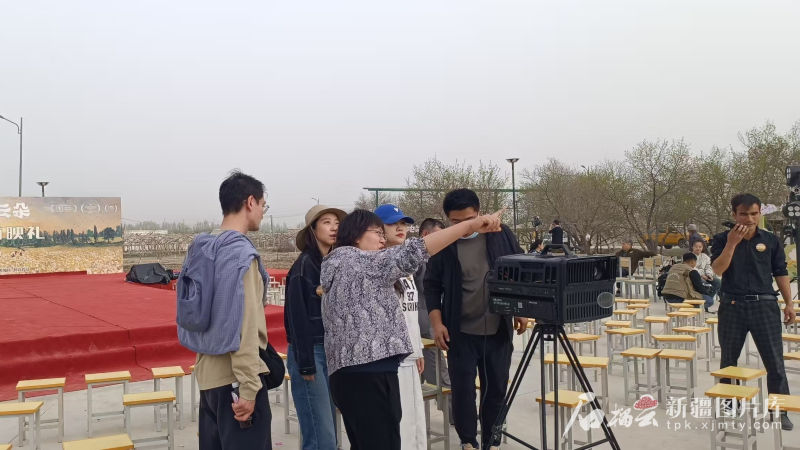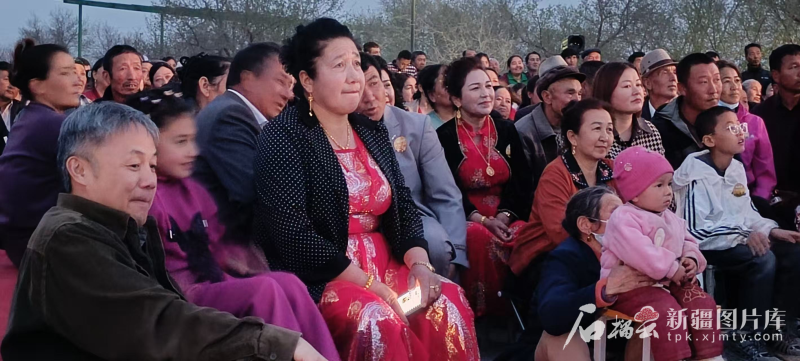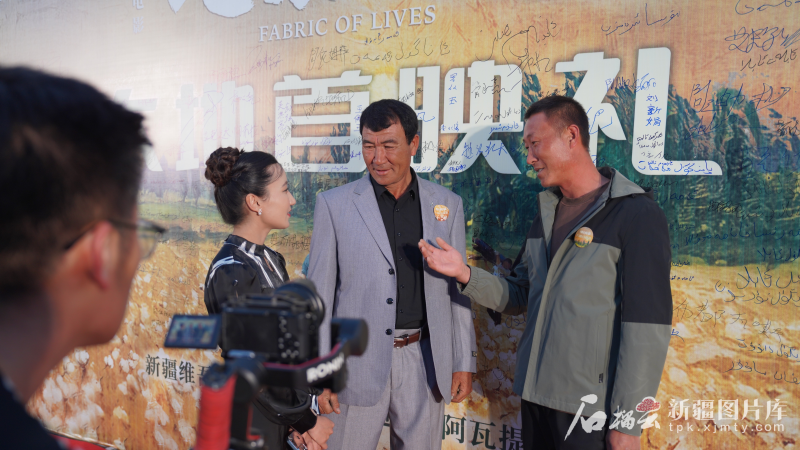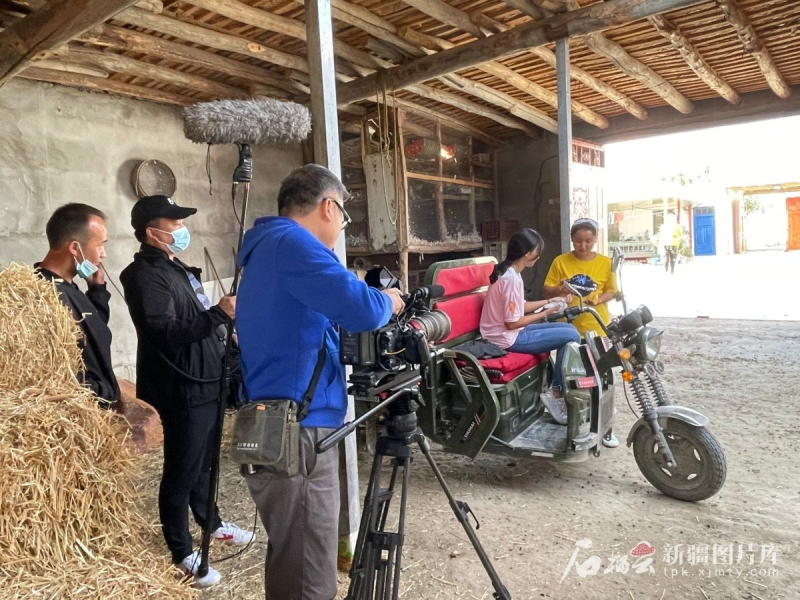Shiliuyun-Xinjiang Daily (Reporter Ren Jiang) news: "The land of Xinjiang carries a magical, raw energy that moved me deeply," said Liu Guoyi, director of the documentary film "Fabric of Lives," who traveled to Xinjiang for the first time to film and was captivated by its essence.

Photo shows the premiere event of "Fabric of Lives," with director Liu Guoyi (third from left) gives directions on site. (Photo by Shiliuyun-Xinjiang Daily/Ren Jiang)
Since "Fabric of Lives" was released in theaters across China on May 7, 2025, more and more people have come to experience the authentic lives of Xinjiang cotton farmers through the film, touched a vivid portrayal of Xinjiang's local customs, and truly sensed the documentary filmmakers' persistent pursuit of truth.
Capturing reality with near-invisible presence
"We went there with curiosity. Although we had done thorough research, we had no specific preconceptions. After arriving, we did see different ways of production and life, but whether we could complete a film was still uncertain. We took our time observing, filming, and letting the story unfold," Liu Guoyi said frankly.
During pre-production, the team gradually learned about the harvest and trade practices while absorbing knowledge about cotton. As they delved deeper, they found the daily routines and emotional bonds within the families deeply moving. "One day, standing in the cotton field, I suddenly felt a strong desire—to present everything our team heard, saw, and felt here to the audience," director Liu Guoyi recalled.

Photo shows the creative team of "Fabric of Lives" watching the film together with cotton farmers featured in the documentary during the premiere. (Photo by Shiliuyun-Xinjiang Daily/Ren Jiang)
"Fabric of Lives" embraces raw authenticity, focusing the lens on ordinary cotton-farming families. It abandons traditional documentary techniques like voiceover narration or interviews, opting instead for the observational filming, where the crew and the camera minimize their presence to near-invisibility.
"Different films and subjects require different filming methods. Our approach wasn't a deliberate choice, but an instinctive sense that this was how it should be done. In my daily life, I'm often drawn to the natural, vivid states of people's conversations and living scenes. These moments feel profoundly beautiful and precious. In Xinjiang, I encountered a different way of life, which ignited a strong urge to preserve these precious moments as authentically as possible," Liu explained.
Recording the joy of harvest
The crew embedded themselves with cotton farmers in Awat County, followed them through planting and harvesting, and witnessed firsthand their hardships when working in the scorching sun, and shared in the happiness of a family counting their earnings together after the harvest. "This kind of filming was challenging. First, the entire team had to internalize that we weren't storytellers but witnesses. We shouldn't stage moments but remain invisible observers. We had to respect them and their authentic lives," said Liu Guoyi.
Real life is mundane; there is no constant drama. Liu and her team trained themselves to be patient, to observe and get the episodes out of daily trivials. This approach generated vast amounts of raw footage, exponentially increasing the difficulty of post-production editing. "Overcoming these challenges is what defines a professional documentary team. For documentarians, the joy lies in traveling to new places, connecting with diverse communities, and immersing ourselves in their lives. The uncertainties during filming and the triumph of completion are equally rewarding."
Authenticity carries its own power. One scene in the film shows a mother and daughter picking cotton in a wind-swept field. The mother spontaneously hums a local folk song, her slightly raspy voice radiating unexpected warmth. "In that moment, it was utterly mesmerizing," Liu recalled. Though the spontaneous scene had imperfect lighting, she initially considered re-filming but ultimately preserved the raw, unrehearsed footage to honor the truth of the moment.

Photo shows two cotton farmer families featured in "Fabric of Lives" have a friendly conversation at the film's premiere in northwest China's Xinjiang Uygur Autonomous Region. (Photo offered by "Fabric of Lives" production team)
"Fabric of Lives" offers a parallel glimpse into the daily lives of two ordinary cotton-farming families in Awat County. Throughout the film, the two households never cross paths. Liu Guoyi shared that the filmmakers talked about bringing them together at the end, but in the end, they decided to keep their stories separate and let them unfold naturally.
Inviting the audience to reflect on this land
In mid-April this year, the "Fabric of Lives" team returned to Awat County to host its premiere in a village square encircled by cotton fields, bringing the story born from this land back to share with the people most familiar with it. "Today, we chose to hold the premiere here to share our collective work with everyone. Please come and see our own lives," Liu Guoyi said to the over 600 villagers present at the premiere.
Barna Arken, daughter of cotton farmer Arken Talip, perfectly captured the film's essence during the fieldside premiere, "The greatest value of the film lies in documenting our true lives." "Fabric of Lives" captures the authenticity and warmth of life in the expansive cotton fields, leaving the audience with reflections on this land and its people.

Photo shows the filming site of "Fabric of Lives." (Photo offered by "Fabric of Lives" production team)
Liu Guoyi found solace in the fact that while the film preserved the authenticity of the families' separate lives. Yet beyond the screen, during the premiere, the two households finally met. "Arken and Zhao Qiang shook hands and greeted each other at the scene, promising to visit each other often, share more conversations, and lend mutual support. That moment is deeply precious to me," Liu recalled.
As "Fabric of Lives" rolls out in theaters across the country, Liu still remembers every filming moment vividly. These scenes remain her strongest impressions of Xinjiang. But her connection to Xinjiang extends far beyond this film. This June, her television documentary about a Xinjiang village famous for its traditional musical instruments is nearing completion, revealing even more of the unique perspectives she has gained about this land.
(A written permission shall be obtained for reprinting, excerpting, copying and mirroring of the contents published on this website. Unauthorized aforementioned act shall be deemed an infringement, of which the actor shall be held accountable under the law.)









